AMD Radeon HD 7790 Review Feat. Sapphire: The First Desktop Sea Islands
by Ryan Smith on March 22, 2013 12:01 AM EST- Posted in
- GPUs
- AMD
- Sapphire
- GCN
- Radeon HD 7000
Power, Temperature, & Noise
Last but not least of course is our look at power, temperature, and noise. AMD designed the Bonaire GPU in the same vein as Cape Verde, making it slightly bigger and slightly more power hungry, but not immensely so. As a result of this and other considerations the 7790’s typical board power is rated at 85W, just 5W over the 7770’s. Now we’ll see how that translates to real world conditions.
Stopping quickly to take a look at voltages, while AMD’s clock averaging algorithm means that we cannot see the individual states, we can still see the idle and top states just as before due to the fact that these are easily sustained states. So we know what kind of voltage our 7790 reference card is pulling at idle and at 1GHz. To that end we’re seeing a idle voltage of 0.894v and a load voltage of 1.263v according to GPU-Z.
| Radeon HD 7790 Voltages | ||||
| Ref 7790 Idle | Ref 7790 Load | Sapphire 7790 Load | ||
| 0.894v | 1.263v | 1.263v | ||
For anyone curious about the impact of the latest rendition of PowerTune, we also recorded the average (average) clockspeed of the 7790 in all of our games. Since PowerTune in this case is being used purely as a throttling mechanism and not as a boost mechanism, there’s actually very little to report here. Our 7790 sustained 1GHz in each and every game. Even in FurMark the average clockspeed was only slightly reduced, to 975MHz. Given what we’re seeing, we don’t see any reason that any other 7790 card shoudn’t be doing the full 1GHz the vast majority of the time.
| Radeon HD 7790 Average Clockspeeds | |||
| Base Clockspeed | 1000MHz | ||
| DiRT:S | 1000MHz | ||
| Shogun 2 | 1000MHz | ||
| Hitman | 1000MHz | ||
| Sleeping Dogs | 1000MHz | ||
| Crysis | 1000MHz | ||
| Far Cry 3 | 1000MHz | ||
| Battlefield 3 | 1000MHz | ||
| Civilization V | 1000MHz | ||
| FurMark | 975MHz | ||
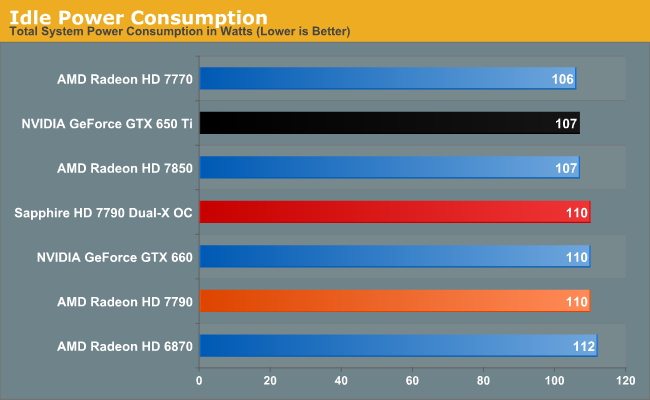
Kicking things off as always is our look at power consumption. We are measuring power consumption at the wall for the entire system, so these numbers are almost entirely composed of everything but the video card, but it still is sensitive enough to identify any cards that may be significantly worse than today’s low-idling cards.
For reasons we’re not entirely sure of, we’re seeing 7790’s idle power consumption come in at just a bit higher than both the 7770 and 7850. As Bonaire is a larger GPU the former isn’t unusual, but it’s not clear why 7790 is pulling more power at idle than the larger yet 7850 and its 2GB of GDDR5. The difference at the wall is only a couple of watts, but it is repeatable.

Looking at our first load power test with Battlefield 3, we can see that our test results are very close to AMD’s typical board power rating. Both the reference and Sapphire 7790 cards are pulling 7W more than the 7770, a hair more than the 5W difference in AMD’s TBP. Considering the fact that the 7790 is nearly 30% faster than the 7770 on average, this is quite an accomplishment on a power/performance basis for AMD in the span of a year. It’s a very reasonable increase in performance for very little of an increase in power consumption. This also means that the 7790 looks good against the 7850; the 7850 is faster, but it draws 22W more at the wall.
But perhaps more interesting is the 7790 against the GTX 650 Ti. The 650 Ti is around 5% faster in this test, but it’s also leading to our testbed drawing 12W more at the wall. As BF3 is a game test, power consumption does scale slightly with performance due to the extra work put on the CPU to generate the additional frames, but a 5% performance difference in this case would not explain a 12W increase in power consumption. NVIDIA has for a long time set the bar on efficiency, but with the 7790 it looks like AMD will finally edge out NVIDIA.
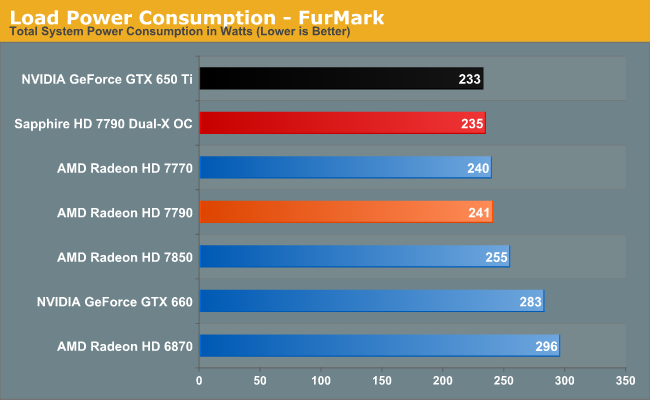
Moving on to FurMark the picture changes a bit. Against the 7770 the 7790 once again looks great, with the difference at the wall being a single watt, while drawing 14W less than the 7850. On the other hand the 7790 is now drawing slightly more than the GTX 650 Ti, but as we’ve see before game tests and FurMark can sometimes be at odd since FurMark is an explicit test of a card’s power throttling systems. NVIDIA looks to be throttling a bit harder than AMD, which would lead to what we’re seeing.
At the same time our 7790 cards show a bit of variance. The Sapphire card, despite being overclocked, draws 6W less than our reference 7790. There are some temperature differences between the cards due to their different coolers, so with the new PowerTune this may be a manifestation of the impact of power. Or it could just be standard variation for 7790, taking into consideration that the GPU in the Sapphire card would be binned. In FurMark this is mostly an intellectual curiosity. Once we have more 7790s we may be able to break it down further.
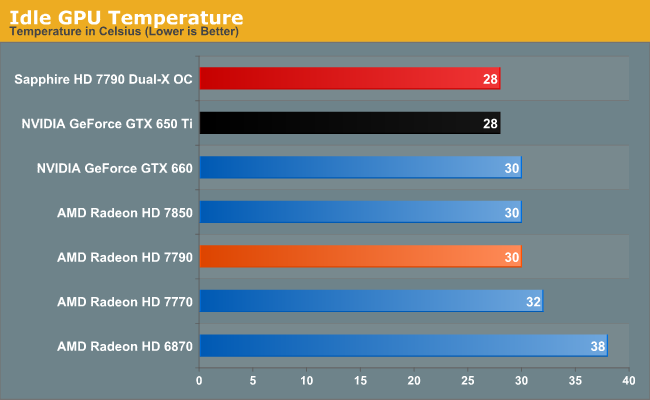
Looking at idle temperatures there are no great surprises here. Sapphire’s Dual-X cooler can bring their card down to 28C, while our reference card hits 30C. Idle temperatures on these low-wattage GPUs aren’t too far above room temperature.
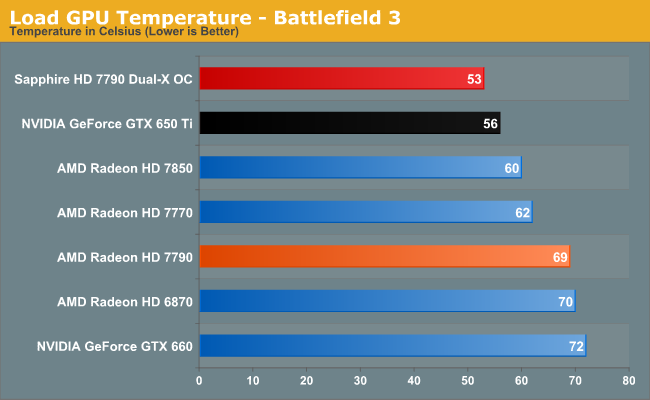
Jumping to load temperatures, the reference 7790 with its admittedly average cooler is particularly average in the temperature department. 69C is warmer than the 7850, 7770, and the GTX 650 Ti, but as it’s still under 70C these are by all considerations still cool temperatures. Sapphire’s cooler in the meantime looks very good here. 53C when running BF3 is quite an accomplishment, especially since our reference GTX 650 Ti does so well in this test.
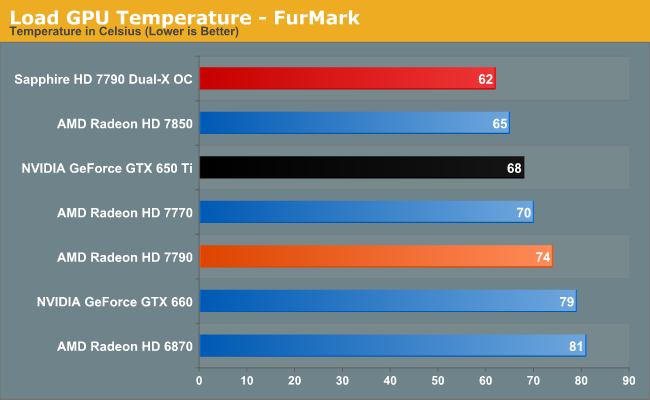
Cranking things up to the max for FurMark, we can see that temperatures are up across the board. The reference 7790 is now at 74C, which is warm but not exceptional. It’s still a low enough power card that even a half-decent cooler is enough to render temperatures meaningless. Meanwhile Sapphire’s card once again takes top honors at a relatively chilly 62C, 3C cooler than the otherwise overbuilt 7850, and 6C cooler than the reference GTX 650 Ti.
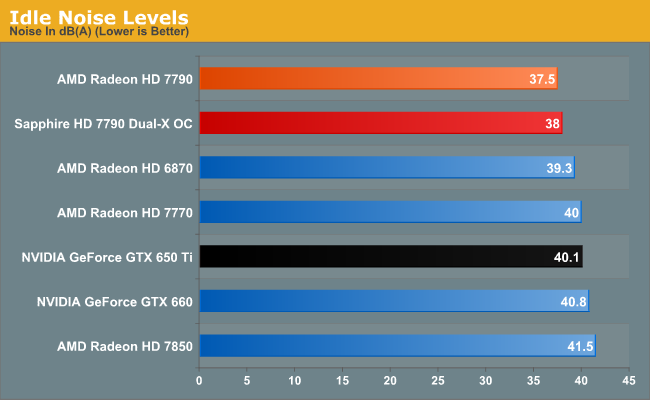
Both of our 7790 cards look good when it comes to idle noise. The reference 7790 with its one fan runs up against the noise floor at 37.5 dB(A), while the Sapphire card with its two fans is just a bit louder at 38 dB(A). In lieu of passive cooling this looks like a decent option for silent PC enthusiasts looking for a quiet idle, though really anything at the GTX 650 Ti level or lower is doing rather well here.
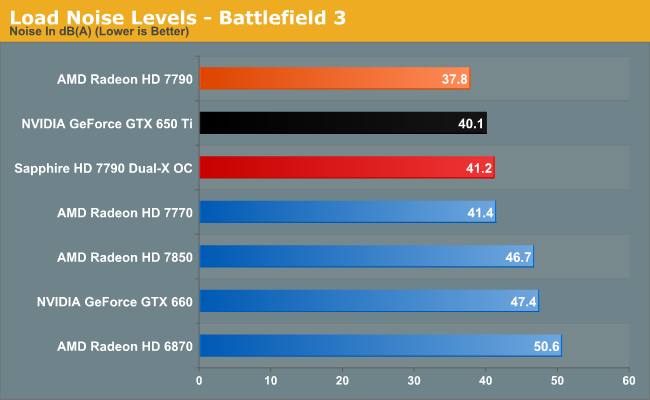
Jumping into load noise, we can see that the reference 7790 and its simple open air cooler thrives with our BF3 testing. Despite the jump in heat dissipation the amount of noise generated by its one fan has jumped by less than 1 dB(A), an almost imperceptible increase. At the same time this paints a picture of the reference 7790 where it looks like it has been optimized for noise over temperature, giving us reasonably acceptable temperatures for fantastic acoustics.
Sapphire’s card on the other hand isn’t set to favor acoustics over temperature, so those great temperatures we saw earlier do come at the expense of some noise. 41.2 dB(A) leaves it effectively tied with the 7770 and quite a bit quieter than the 7850, but over 3 dB(A) louder than the reference 7790, and 2 dB(A) louder than the GTX 650 Ti. If you’re looking for near-absolute silence here there is a clear benefit to the reference 7790 over Sapphire’s card, but 41.2 dB(A) is nothing to sneeze at.
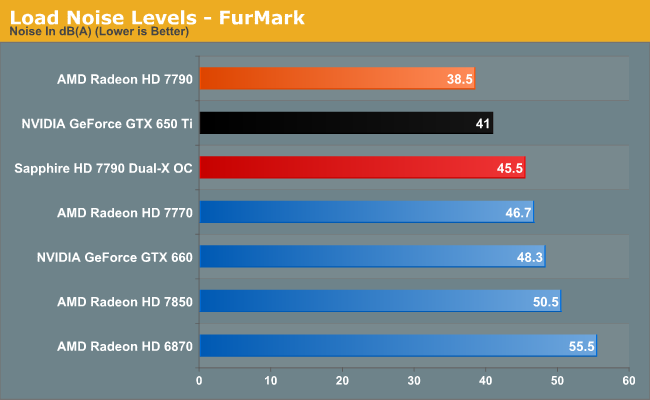
Finally we have our look at noise under FurMark. Again the reference 7790 does very well here, coming in at 38.5 dB(A), amazingly quiet for a >75W card under FurMark. This is over 8 dB(A) quieter than the 7770, 12 dB(A) quieter than the 7850, and over 2 dB(A) quieter than the GTX 650 Ti. AMD is more interested in pushing partner cards than their own design, but right now right here the reference design is looking very good.
As for Sapphire’s card, once more we see it favoring temperatures over noise. 45.5 dB(A) is still quieter than the reference 7770, so Sapphire isn’t doing badly here. But the reference 7790 and even the GTX 650 Ti back it into a corner. If you care about noise than the reference 7790 is a better configuration, but if you care about temperature the Sapphire is going to be a tough act to beat.
It goes without saying of course that these noise improvements come despite a 30%+ increase in performance over the 7770, and contrast against a marginal increase in power consumption. The price difference between the 7770 and 7790 put them in distinctly different categories, but the 7790s we’re seeing are clear improvements over the 7770 in practically every way. These gains aren’t quite as remarkable when placed against the GTX 650 Ti due to the latter’s high efficiency out of the gate, however that doesn’t mean AMD hasn’t managed to surpass NVIDIA here. BF3 power consumption and noise testing on our reference 7790 tells us that AMD can edge out NVIDIA in the efficiency department here, especially since this comes with a 10% performance improvement.










107 Comments
View All Comments
silverblue - Friday, March 22, 2013 - link
You must've missed the part about them simply not having as much time to test the 7790 as they'd have liked because they were at GTC. Other sites apologised for their lack of time as well.There's a whole load of other reviews out there; only a few have overclocking results (Guru3D notably), and as far as I can see only AT, of the major sites, has both the 7790 and a factory overclocked 7790 in the same test. Guru3D is alone in providing a CrossFire test and though two 7790s perform about the same as a sole 670, there's no power readings. There's a good number of different titles being benchmarked so it's not strictly a list of AMD-says-test-these-titles, plus Tomb Raider, a Gaming Evolved title, performs better on NVIDIA hardware. There's a few bugs with the beta drivers used for the 7790 in these reviews most notably with latencies (a bug that has already been fixed with the next Catalyst release so yes, we will see new drivers soon), however the latency values are so far ahead on average of what we used to see from AMD that this can hardly be classed as an issue. Testing has generally centred on 1920x1080 because that's really the limit where cards like this are supposed to be performing - there's little point in 1024x768 and an equal measure of futility trying for 5760x1080 or whatever; the former is ridiculously low res and the latter is ridiculously ambitious even for a 7970 or 670/680.
Sapphire's blurb about multi-monitor usage via the TweakTown website:
"Working or gaming with multiple monitors is becoming increasingly popular, and the SAPPHIRE HD 7700 series supports this with AMD Eyefinity, now in its second generation. The SAPPHIRE HD 7790 OC Edition has two DVI ports (DVI-I and DVI-D), HDMI and a single DisplayPort output, supporting up to four monitors.
The SAPPHIRE HD 7790 OC Edition model supports the FleX feature, pioneered by SAPPHIRE, that allows three digital displays to be connected to the DVI and HDMI outputs and used in AMD Eyefinity mode without the need for an external active adapter. All four outputs can be used in AMD Eyefinity mode, but the fourth display must be a DisplayPort monitor or connected with an active adapter."
I've heard AMD's launch date for this is today; Guru3D has the following to say:
"But I need to add this little note alright; AMD's Never Settle Reloaded promotion continues. At participating retailers beginning 02 April, 2013, gamers will be able to receive a free copy of BioShock Infinite with a purchase of their new AMD Radeon HD 7790 graphics card. See, now that's great value. The Radeon HD 7790 series cards will be available in stores starting April 2, 2013"
Trusting this is of some use to you...
CeriseCogburn - Sunday, March 24, 2013 - link
I've run 2 flex edition cards, you idiot.Have you ?
Run any MDT nVidia galaxy cards dummy ?
How about all dvi outs so you daon't have to have $100's of dollars of soon to die amd dangly cables ?
Heck a friend just got ANOTHER 6870 he usually runs 4 monitors, but that could only run 2 OOB and he has loads of cables, so he had to buy another cable just to run a 3rd monitor - it took 2 weeks to arrive...
ROFL
AMD SUCKS with eyefinity / multiple monitors and nVidia DOES NOT - nVidia keeps the end user in mind and makes it INEXPENSIVE to set up 3 or 4 monitors !
Amd makes it cost prohibitive.
AMD SUCKS, they lost again, totally.
geniusloci - Saturday, March 23, 2013 - link
You are a pathetically simple little mind, aren't you?geniusloci - Saturday, March 23, 2013 - link
What planet do you come from?This card will run 4 monitors, eyefinity has done this very well, forever. With discrete audio per monitor. Nvidia is really getting handed it's ass by AMD in this category.
This card will spank it's nvidia competition in civ5, since civ uses opencl, and nvidia sucks at opencl (and their current cards even suck at cuda).
Crossfire: there's a crossfire port at the top, genius. It will obviously crossfire.
Too bad Nvidia's 2D quality and video quality is such utter shit. I might have actually used that gtx660 I bought instead of sending it back for a 7870.
CeriseCogburn - Sunday, March 24, 2013 - link
You have your display port monitor or $100 active display cable dummy ? LOL4 monitors MY BUTT.
Another clueless amd fanboy.
eric.zaba@gmail.com - Sunday, March 24, 2013 - link
You obviously dont have a clear understanding of gpu tech so just stop blabbing your stupidity, even most nvidia biased people can admit Check linus tech tips , check your games they all work much better on amd with multimonitor.and no overclock talk maybe because AMD doesnt approve of people tampering with gpus............ and because they want it to seem so good that you dont need an overclock...... and the specific hardware partners can make different port configs so why would you say that?
and maybe comparing ASUS 650tis to this GPU is invalid becuase you didnt specify who made it so the port config advantage is completely irrelevant.
Amd is not bankrupt because of their GPU business. and their CPU business isnt bad i dont think that getting into the gpu and cpu of the top 3 consoles (PS4 Xbox WiiU) is so bad either. and why would game biases not be true if amds drivers and games play better on the amd based systems
eg: Crysis 3. and saying that the civ 5 benches crashed is completely stupid because a good website like anandtech doesnt normally disregard such things. and AMD didnt pay them off if they are bankrupt right? yes it can crossfire because theres crossfire connectors on the top so maybe they assumed things would be implied for the general crowd.
althaz - Friday, March 22, 2013 - link
I think it's also worth mentioning that the 7850 is a quite excellent overclocker. At stock I think it's definitely not worth the extra $30, but once overclocking is taken into account, if you can afford the $30 you are crazy not to spend it (assuming you are comfortable with overclocking of course).Bob Todd - Friday, March 22, 2013 - link
Yeah, I'm curious what the pricing will look like on these a few weeks after introduction. I picked up a 7850 (2GB MSI Twin Frozr) for $170 AR a few weeks ago to put in a HTPC, and I've seen it at that price again already. It will be interesting to see if the regular sales on 7850s decrease once the 7790 is out. Kudos to AMD for offering BioShock Infinite with this.Aikouka - Friday, March 22, 2013 - link
Given we're talking about gaming cards here, I think it's worthwhile to add that only the 7800s and 7900s come with AMD's Never Settle game promotion. So, if you're interested Tomb Raider and/or Bioshock Infinite, the 7850 may have significantly more value to you. If you're not interested in them, people have been selling the coupons on eBay for about $50-60 each.Bob Todd - Friday, March 22, 2013 - link
There's a small paragraph in the article explaining that this card _is_ part of the Never Settle Reloaded program. It's only getting BioShock Infinite since it sits at a lower price point, but still a nice addition. The bundles are a big part of the reason I'm curious to see how the pricing shakes out. I sold a TR/BS bundle and kept about ~$50 in my pocket after fees, so I basically got a very nice 2GB 7850 for $120. You could obviously sell the BioShock code you'd get with a 7790, but if the prices for that card stay at MSRP for too long they'll have some stiff competition from 7850s on sale. Unless of course the 7850 sales dry up since it doesn't have to cover such a large swath of AMD's lineup now price wise.